Story time…. In 1978 I went down to Corona del Mar, CA to take a two week workshop at the studio of Rex Brant and his wife Joan Irving on Goldenrod Ave. We had been living in Oregon for two year, having moved there from the East Coast — where I had learned to paint in watercolor. I was now teaching watercolor to others.
 Rex Brandt
Rex Brandt
About the second night of the class Rex showed slides of the California School of watercolorists: Phil Dike, George Post, Millard Sheets, Rex and Joannie and others. Rex seemed to be saying that these watercolorists were a) different from the rest of the country and b) better. They got outside and painted what they loved. For Rex, a sailor, small sailboats and his section of the coast were his main source of inspiration. For Joan, the children, the laundry blowing, flowers on a window sill.
Rex and Joan became dear friends over time and many workshops. during this period I was taking groups to the Greek Islands to paint. One year Rex wrote me, “You know Joannie and I would love to come with you to Greece. But we still don’t feel we have painted all the paintings we want to do here in our own backyard.”
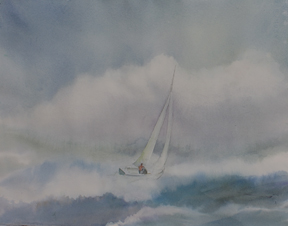 When they came to Oregon and juried the Watercolor Society of Oregon’s fall show in 1981, the event was held at Lincoln City. That weekend we were shrouded in a heavy fog with the wet sand disappearing into the the ocean and the low sky. Looking at the painting of a dory drawn up on the sand which someone had entered, Rex demanded, “Where is this? This boat isn’t from here. This shore isn’t Oregon!” He was right. It looked like a generic anywhere boat, placemat for a seafood restaurant.
When they came to Oregon and juried the Watercolor Society of Oregon’s fall show in 1981, the event was held at Lincoln City. That weekend we were shrouded in a heavy fog with the wet sand disappearing into the the ocean and the low sky. Looking at the painting of a dory drawn up on the sand which someone had entered, Rex demanded, “Where is this? This boat isn’t from here. This shore isn’t Oregon!” He was right. It looked like a generic anywhere boat, placemat for a seafood restaurant.
Winter Sail, painted after I was down on our dock in January and asked myself “why aren’t you painting this.” My husband was off sailing so I added the boat.
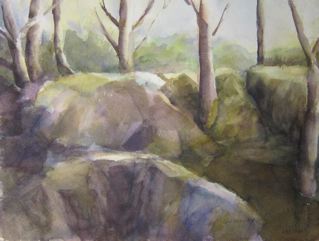 A few years later I had been given the job of entertaining Millard Sheets him while the committee hung the show he had just juried in Eugene for the Watercolor Society of Oregon. It was a dank, gray late-winter day as we drove the road to the Coast. The gray-barked tress were draped in green-gray moss while below them a soft red announced the swelling branches of a coming spring. A dull beige grass spoke of the year past.
A few years later I had been given the job of entertaining Millard Sheets him while the committee hung the show he had just juried in Eugene for the Watercolor Society of Oregon. It was a dank, gray late-winter day as we drove the road to the Coast. The gray-barked tress were draped in green-gray moss while below them a soft red announced the swelling branches of a coming spring. A dull beige grass spoke of the year past.
Winter Woods, Courtesy of Nancy Hathaway
Millard exclaimed, “Not once did I see this palette! Don’t these people live here? Aren’t these their colors? Why weren’t these colors in their paintings?”
Are you looking around? Is what is happening on your street, in your winter-crumpled backyard, on your window sill — invisible to you? Or do you see the possiblity of a painting there?
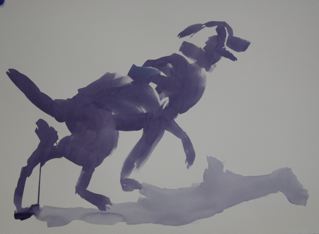 What about the two gentlemen who meet at the market every day for coffee? What about the tired workers waiting for a bus? Or the dogs in the the dog park?
What about the two gentlemen who meet at the market every day for coffee? What about the tired workers waiting for a bus? Or the dogs in the the dog park?
In the Dog Park, Sally Mitchell; full sheet, big brush with no drawing.
We don’t have to do epic scenes of grandeur. Are there horses in your pasture? Or cats by your sliding glass door? Birds at the bird feeder? Music on the piano. Pots in the sink.
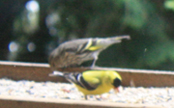 Where is the painting in what you see when you step out your door? What are the colors?
Where is the painting in what you see when you step out your door? What are the colors?
You have a story to tell. You have a story that ONLY YOU can tell. Can you make that your art?
Try it this winter.
Happy painting,
Caroline
© 2015 Caroline Buchanan
If you are interested in learning more about The California Scene Painters, see the DVD Visions of Calfornia, The Story of California Scene Painting, 1925-1950 (before Brandt was very active). I got mine from The Irvine Museum, but there are also other sources.
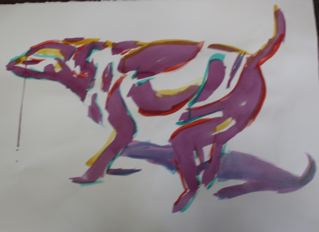
Sally Mitchell
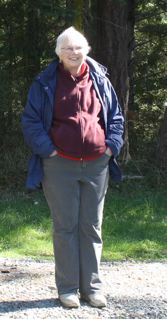
Sally Mitchell
BLOG UPDATE 12/10/15
I received replies from both Nancy and Sally when I asked them if I could use photos of their paintings. I would like to share them with you. And I welcome all responses: watercolors@rockisland.com
Sally first:
That was an extraordinary day. I’m not sure I ever told you what prompted that dog-session. I arrived at class without my usual reading glasses, only my bifocals, which are really uncomfortaable for me to paint in. I decided to just go for something different, since I was already out of my comfort zone optically, and I chose the whole-sheet dogs. It was such fun , and I forgot that I was wearing the wrong glasses.
Caroline here: she had the full sheet paintings on a table easel and was able to step back time and again as she painted with a large (2 inch ?) brush.
Sally Mitchell
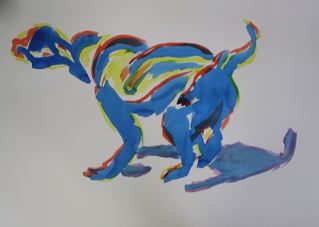
Nancy:
Your blog made me want to tell you about “what kind of painter I am.” However, for me, this question has taken on a broader perspective this year.
To might recall that I am heading a start-up bio-tech company as part of my “encore” career. As a result, I go to many interesting discussions about business, leadership, etc.
I heard something the other day that resonated with me. The challenge presented was to understand the trajectory I am on and how I can add more value. So, I’ve been thinking about this….
Given that I am not a young person anymore, I have many years to look back upon which help me identify my “trajectory” from a historical perspective, and now I have the added benefit of time to “feel” and “reason” through my responses to that which is presented each day. This last year of freedom from the day-job combined with time to reflect has been very meaningful because i can begin to seee the connetions between my day-job (“professional”) self, my artist-self, my gardener-self, my dog-mommy self (which needs work these days — more on this another time), and my life partner (wife) self (this is evolving rapidly right now). I am beginning to understand the traits that carry through all of these activities (akin to understanding one’s preferred palette, and what needs updating) and this is helping me see who I am through choices I have made, how I participate in life and how this has eveolved, and what I have to do to more fully put myself forward (engage myself in the opportunities presented) while I still have the ability to add my voice to the dialogue of life.
So why am I writing this/ I feel a need to give words to this strange process. Without words, my understanding remains limited. I hope that you will forgive me if I am boring you.
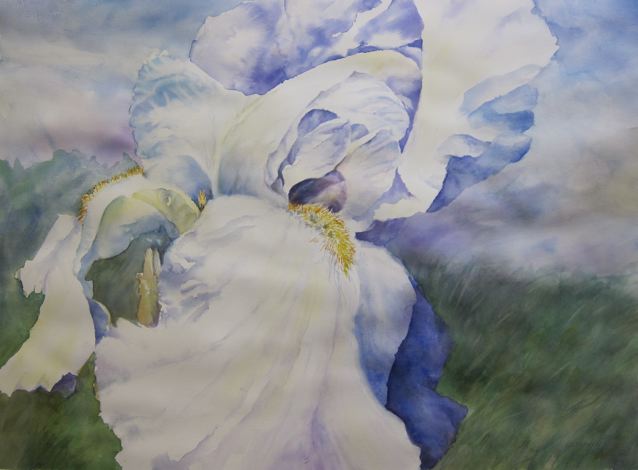
Nancy Hathaway: started in August class; finished in Indiana.
The biggest change I’ve noticed in myself over the years is that I’ve slowly allowed myself to have a “light but intentional touch.” This evolved from having “no touch” (no voice) to a “vague touch” (angry voice).
The recent years have been a migration to a gentle, light touch. Now I want to make paintings that take people to a quiet place in themselves for contemplatuion. Currently I am obsessed with the sky because of its fluidity, and the vast range of possibilities for creating stories that engage our emotions.
In my professional life, I want to offer leadership that expands a team’s awareness of possibilities and emboldens execution of those possibilities in a strategic manner. I wish I could add the word “playful” to that last sentence, but I am not there yet.
As a wife, I want to offer my partner a foundation that even an earthquake will not move, and a home that protects his dreaming spirit. I think all of this can be done with a “light touch” — that is what I want to perfect.
So it’s the “touch” I really care about right now. This is likely why I love watercolor so much — it allows me to see the most subtle impacts of my choices and touch — and it doesn’t allow me to hide from myself. It insists that I am awake to the present. It helps me live with intention. It helps me be honest with myself.
There are so many ways to live, but I want to live lightly, gracefully, with dignity and integrity. Even in “not nice” situations, I want to see the beauty and not succumb to fear or negativity. In my professional life I want to bring out the best in those around me. I am not proficient at any of this, but that’s the value I want to add while time remains.
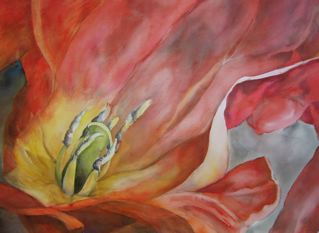 And, back to the original question, “How can I add more value?” I think for me the answer is to apply a light touch with intention, to hold back when my “comment” is not needed, to add definition when clarity is needed.
And, back to the original question, “How can I add more value?” I think for me the answer is to apply a light touch with intention, to hold back when my “comment” is not needed, to add definition when clarity is needed.
So back to the question presented by your blog: What kind of painter are you? Are you a regional painter?
I hope that I am a painter that embraces and loves where I am in the world; that I am open enough to “see” where I am, and clever enough to not let my habits inhibit my ability to translate my experience to paper.
One of the (many) things I love about studying with you is that you have allowed me to see the world through your eyes. You shared with me what you saw and I had the opportunity to actually observe (for a short time) the environment you were responding to — so I could make the connection. Beause of you, I see colors in the landscape around me that I had never seen before and I see multiple ways of telling a story.
You have opened my eyes. You have been so very gentle with me. Thank you.
Love,
Nancy [Hathaway]
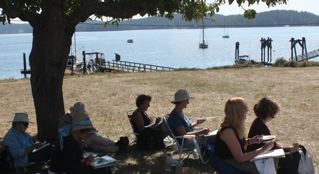
Nancy on the far right; watercolor sketching 2015
Nancy on the far right; watercolor sketching 2015
Caroline here:
I almost left out the compliment because I don’t want to have this an endorsement. I wrote to my husband when I forwarded Nancy’s email, “This is why I teach.” A teacher is a catalyst. A good teacher inspires students to go way beyond where he or she is. I hope Susan’s and Nancy’s responses will help you to reflect on what kind of painter are you and what kind of trajectory you are on.
Have a happy new year and all the years to come!
Caroline
